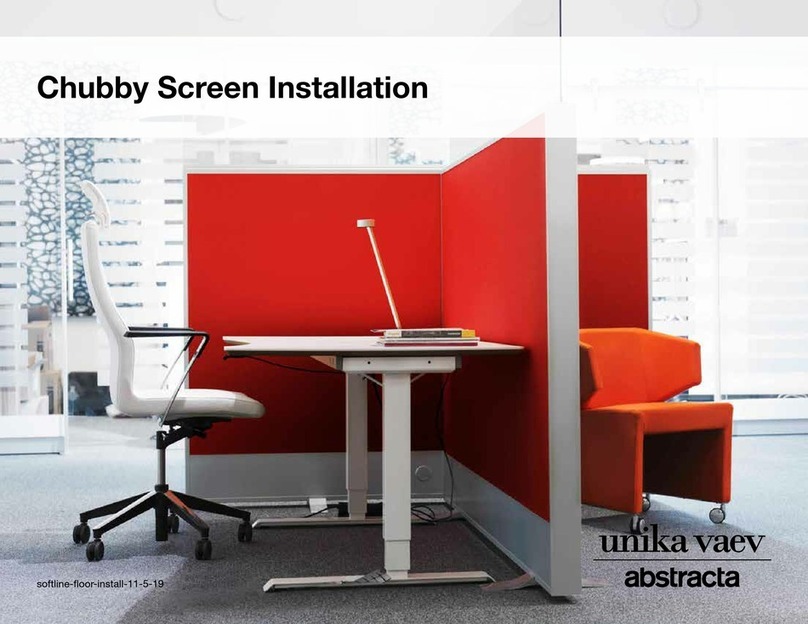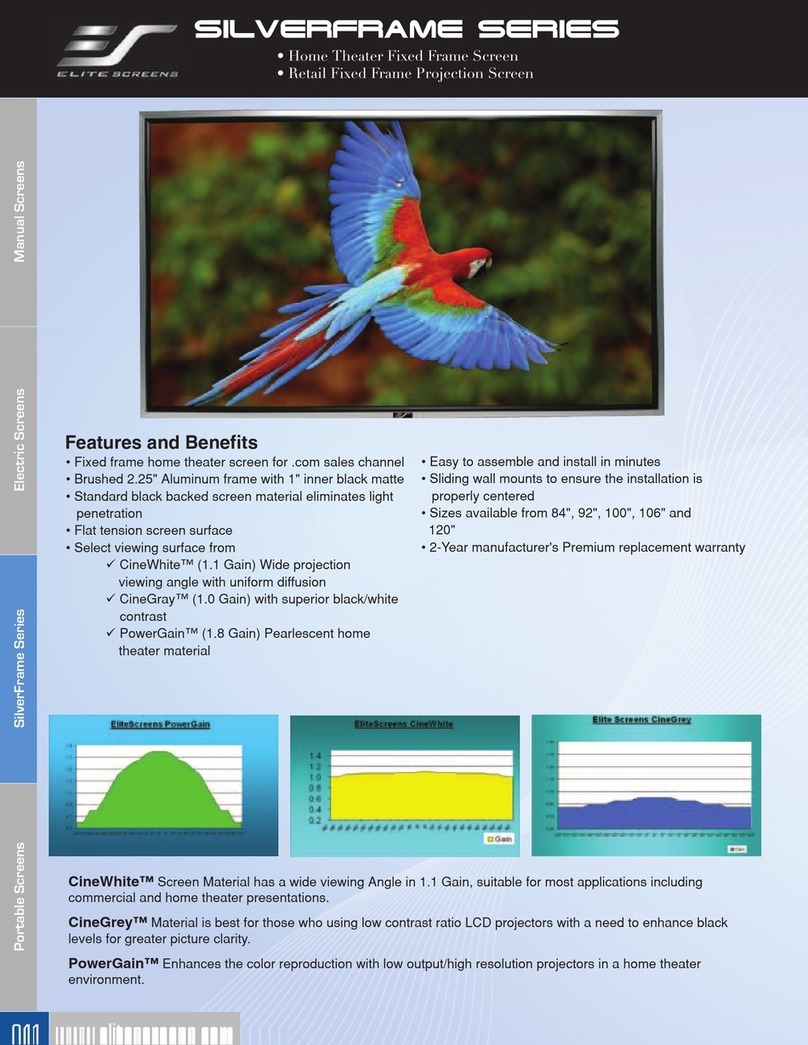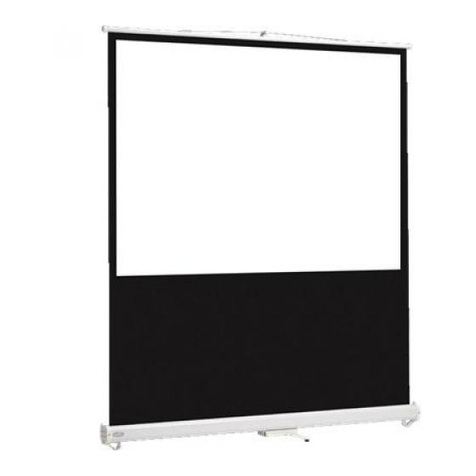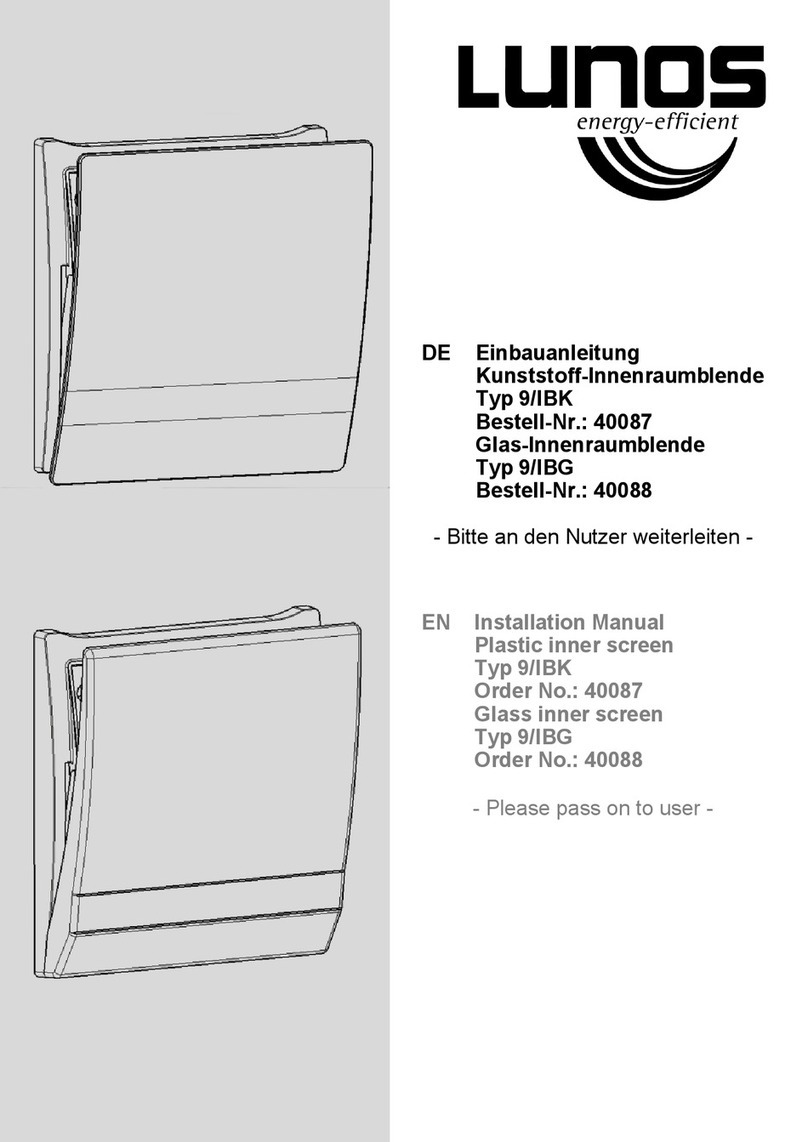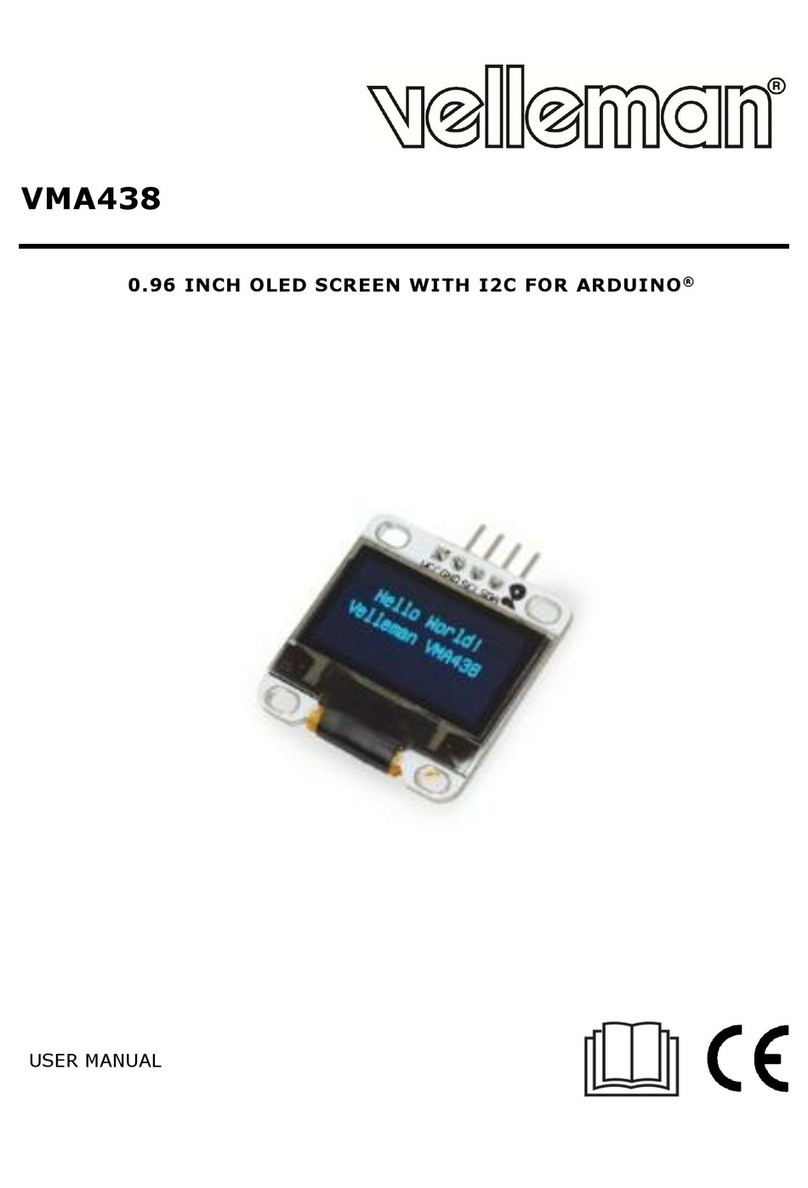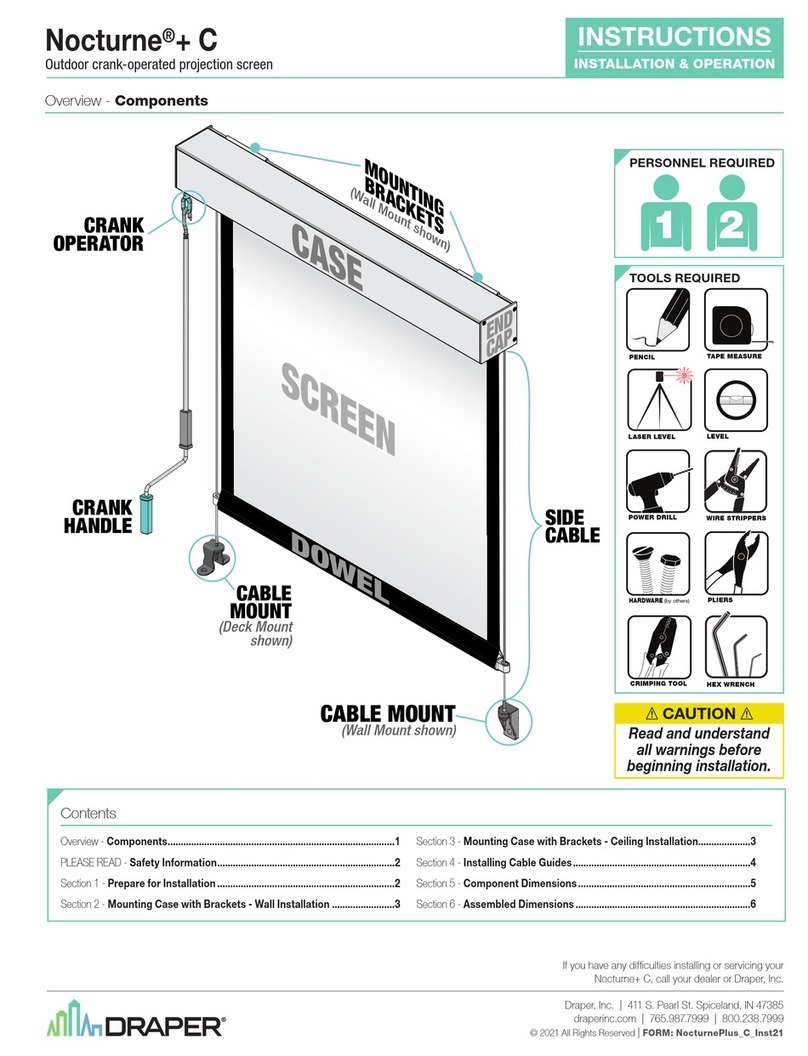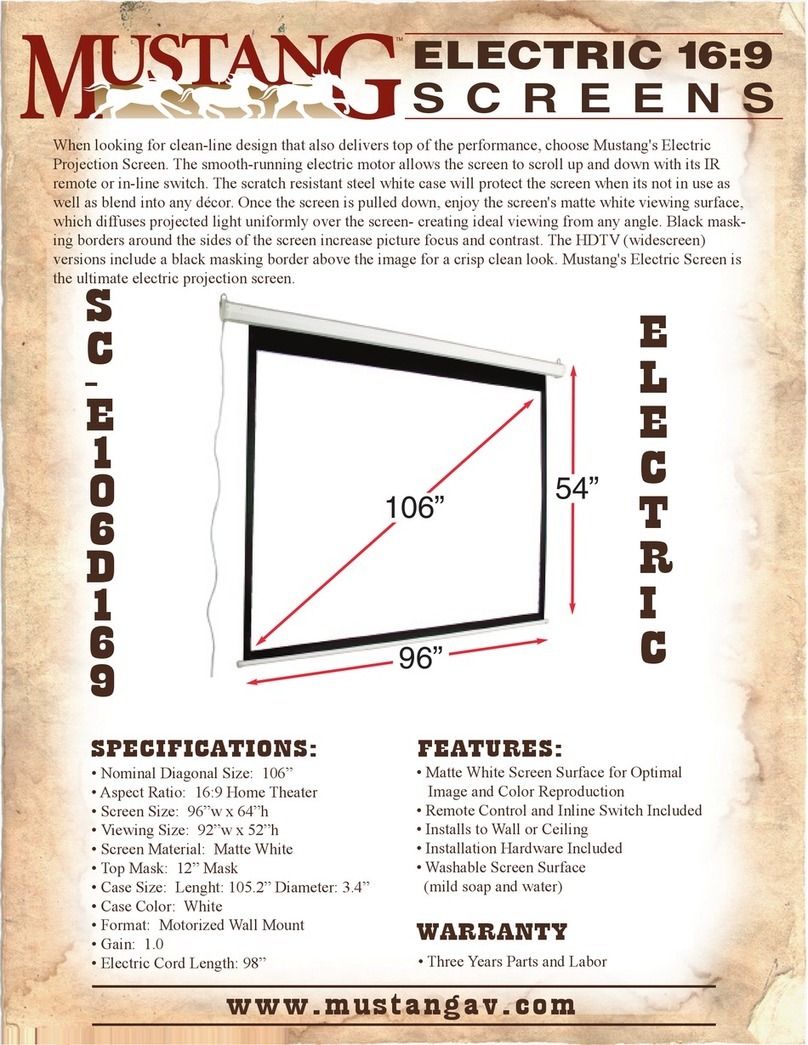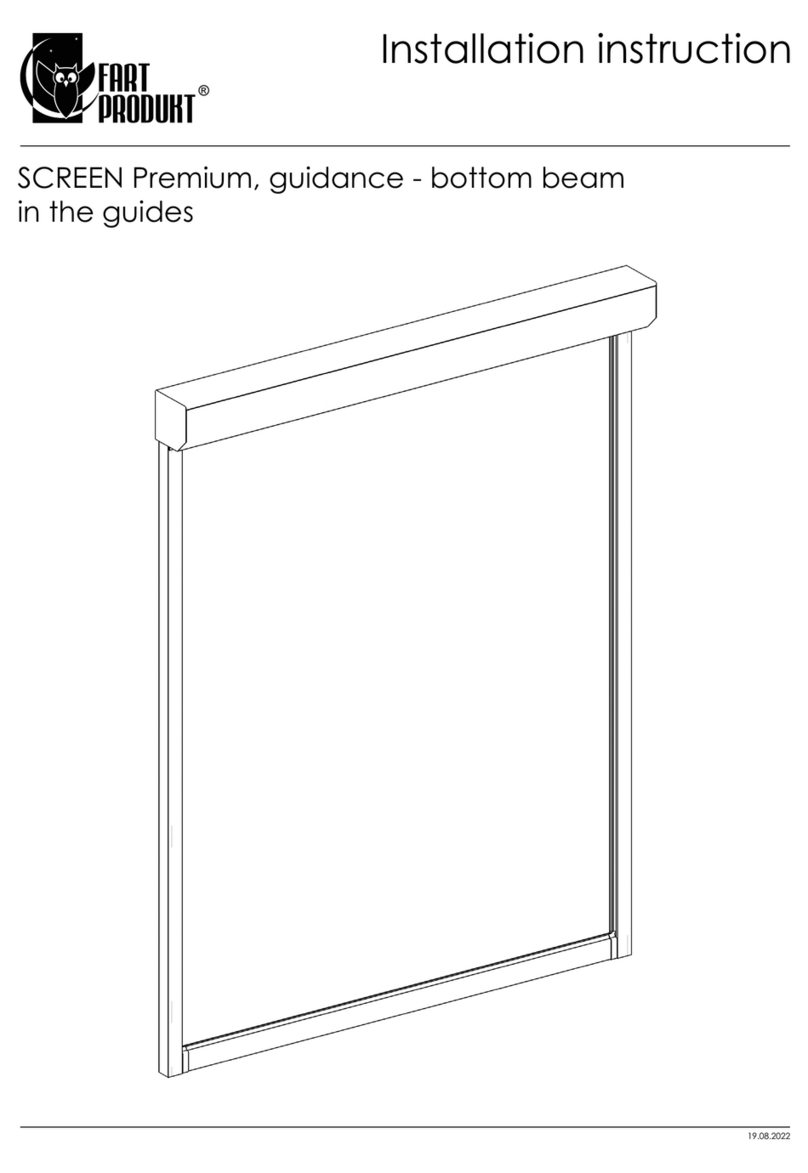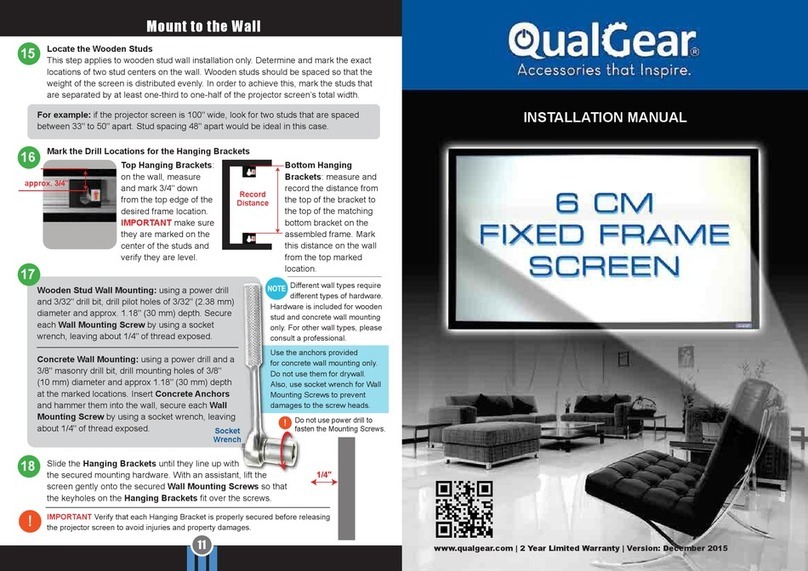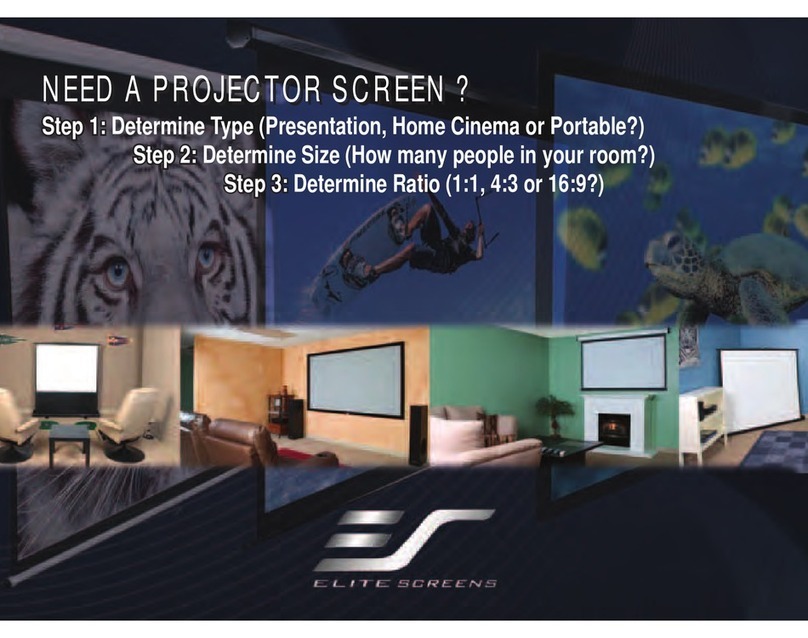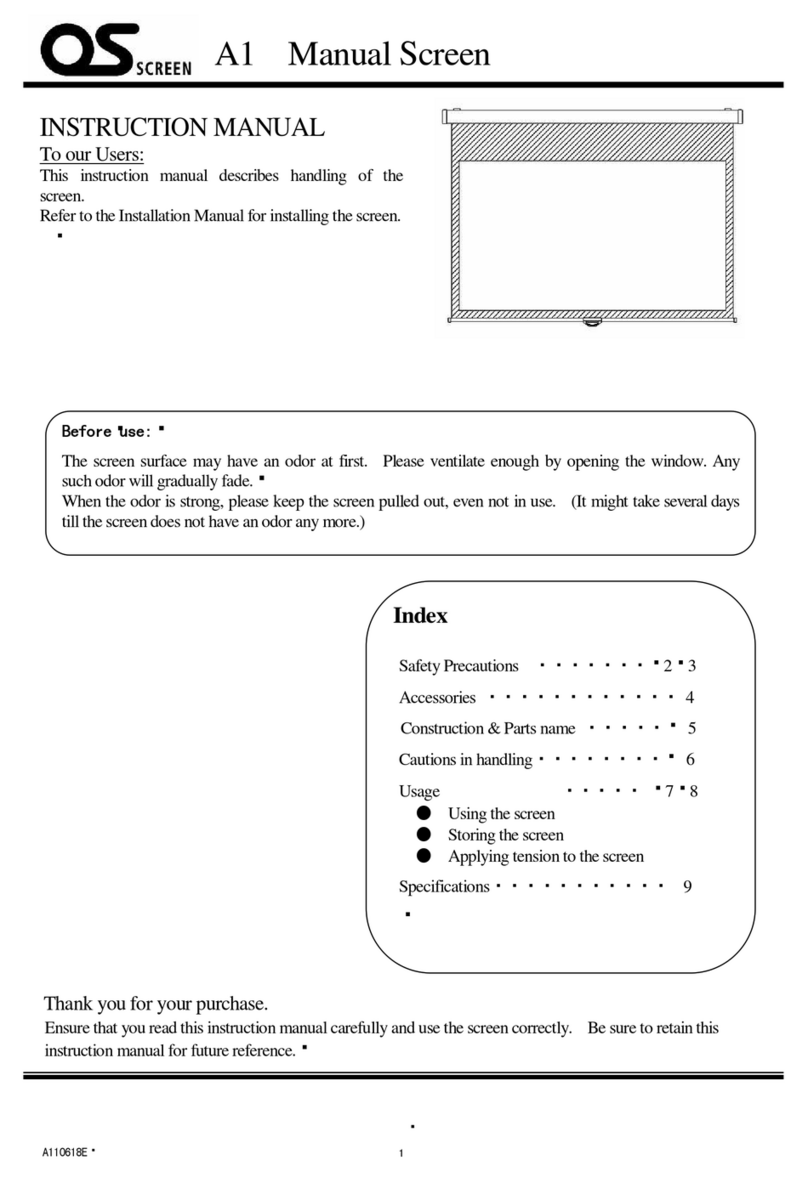Stewart Audio AB Electriscreen User manual

TO THE INSTALLER: BE SURE TO LEAVE THIS MANUAL WITH THE OWNER.
AB-1005
AB Electriscreen
To the Owner
Installation Instructions
Operating the Screen
Maintenance
OWNER’S MANUAL

Printed in U.S.A.
©2001 - 2005 Stewart Filmscreen Corporation
Stewart Filmscreen reserves the right to make changes to the product specified in this document.
From time to time, this document is updated. Current versions of documentation are posted on the Stewart Filmscreen website at
www.stewartfilm.com.

Contents
To the Owner . . . . . . . . . . . . . . . . . . . . . . . . . . . . . . . . . . . . . . 2
Preparing the Installation . . . . . . . . . . . . . . . . . . . . . . . . . . . . . 2
Step 1. Hanging the Case . . . . . . . . . . . . . . . . . . . . . . . . . . . . 4
Step 2. Electrical Hook-up . . . . . . . . . . . . . . . . . . . . . . . . . . . . 5
Operating the Screen . . . . . . . . . . . . . . . . . . . . . . . . . . . . . . 10
Adjusting the Screen Extension . . . . . . . . . . . . . . . . . . . . . . . 10
Screen Care and Cleaning . . . . . . . . . . . . . . . . . . . . . . . . . . 12
Troubleshooting . . . . . . . . . . . . . . . . . . . . . . . . . . . . . . . . . . . 13
AB Electriscreen: Owner’s Manual 1
AB Electriscreen
OWNER’S MANUAL

Congratulations on your purchase of the finest optical viewing screen
available anywhere in the world!
Please take a moment to review this manual, it will help ensure you many
years of trouble-free service from your new Stewart Filmscreen product.
About your AB Series Electriscreen
Your AB Electriscreen offers the most technologically advanced roller screen
in the world.
The maximum overall screen dimensions of the Model AB are
14’ high by 18’ 3” wide (4.3 m by 5.6 m).
Preparation
Specifications regarding the individual screen dimensions, weight, mounting
type, and controls are provided by the factory when the unit is ordered.
Before beginning the installation:
Check the specifications for the type of mounting and switch
control to be used.
Ensure that the mounting area and electrical connection are
prepared.
Check the size and weight of the screen to be installed so that
you can plan for the number of people required for the mounting
procedure. You need at least two people to mount the smaller
screens; more are needed for larger, heavier screens.
You will need:
Enough ladders and/or hydraulic lifts for the personnel supporting
the screen during the mounting process
A level
Fasteners appropriate for the surface on which the screen is
being mounted (See instructions for the type of mount for
recommendations.)
2Stewart Filmscreen Corporation
TO THE OWNER
PREPARING THE INSTALLATION
Before proceeding with the installation of this screen,
take time to thoroughly read and understand these
installation and operation instructions.
All electrical wiring installations must conform to local
and national codes and should be performed by
qualified service personnel.
There are no user-serviceable parts contained within
the unit.

Note: This manual refers to “AC” to represent electrical power. Your
location may use 120 V, 220 V or other electrical power. Screen systems
are manufactured using the electrical power type specified for the location.
Use appropriate power sources for your location.
Unpacking
1. Do not remove the wrapping paper rolled with the screen. You
should remove it only after the unit is hung and all electrical
connections have been made.
2. Remove the batten lock-down screws located on the back side of
the case
AB Electriscreen: Owner’s Manual 3
Caution
During installation, do not place the unit on an unstable
cart, stand, table, or ladder. The unit may fall, causing injury
to a child or adult and damage to the unit.
Warning!
Failure to remove the batten lock-down screws can result in
permanent damage to the screen.
Factory Advisory
The factory advises against installing a concealed or
recessed electrical projection screen permanently. You
must be able to access the external end plates should
future service to the screen roller assembly be necessary.
Suggested solutions for removing the unit include:
A removable ceiling cover plate under the mounting
location.
Access to the unit through an attic or overhead space.

Professional mounting techniques should be used. Stewart Filmscreen
Corporation cannot be liable for substandard or faulty installations.
Make sure that you mount the screen so that the electrical box is on the left
side (audience left).
Installing the unit
The AB Electriscreen is ready to install into the ceiling or soffit. A false
ceiling is not intended to support the weight of an AB Electriscreen. If
enclosing the AB Electriscreen in a ceiling, make sure to provide 6” x 12” /
15 - 30 cm access panels for future service.
The screen can be bolted directly to the support structure or suspended. If
the unit is to be mounted to plaster, drywall, masonry, or other type of
surface, use an appropriate fastener.
1. Install the unit onto the support structure. Refer to Figure 1.
2. Make sure the unit is level.
4Stewart Filmscreen Corporation
STEP 1. HANGING THE CASE
Figure 1: AB Electriscreen
Support Structure
Main AC Power
J-box Switch Input
J-box
Screen

AB Electriscreen: Owner’s Manual 5
The motor requires standard AC power (unless an alternate voltage has
been specified). All connections are made to the electrical box on the side
of the unit (audience left).
There are several kinds of switch controls available. Follow the installation
procedure for the type of switch control you will install.
General suggestions for wiring:
Soldering is recommended.
The use of wire nuts is acceptable.
STEP 2. ELECTRICAL HOOK-UP
Caution
Professional techniques should be used when making any
electrical connection. A qualified electrician should perform
these procedures.
Be sure to follow all standard safety procedures for
installing electrical devices.
Do not disassemble or alter the configuration of the motor
or the unit's electrical connections. This may cause injury to
you or damage to the product.
The electrical connection should be made only to the type
of power source indicated on the marking label.

6Stewart Filmscreen Corporation
Installing the low-voltage 3-button switch (standard)
The Stewart Filmscreen low-voltage control allows the use of low-voltage
wire to connect to the supplied 3-position 24V momentary wall switch.
Preparing the connection
Before making the electrical connections, you need:
An available AC constant power source
A 4-conductor switch hook-up cable (4-conductor bell wire or
category 5 cable is typically used for long runs)
Cat 5, multi-conductor unshielded, or similar type electronic cable
can be used to connect the 3-button switch to the LVC. The
recommended wire gauge is 20 to 24 AWG. Use plenum-rated
cable when required.
Making the connection
Figure 2 illustrates the connections.
1. Connect the 4-conductor hookup cable to the connection harness
coming from the J-box used for “switch input.”
2. Connect the hookup cable to the 3-button switch.
3. Connect the main AC power source to the AC J-box.
4. A parallel connection to an outboard audio-visual switching
network can be made at this time. (optional)
Figure 2: Low voltage 3-button switch wiring 3-button Momentary
Switch
4 Conductor Hook-up Cable—20-24ga Recommended
Category 5 Typically Used (NOT Supplied)
Connection
Harness
J-box for
Switch Input
STOP-Yellow
COMMON-White
UP-Red
DOWN-Black
NEUTRAL-White
GREEN-Ground
HOT-Black

AB Electriscreen: Owner’s Manual 7
Installing the infrared remote control option
The optional Stewart Filmscreen infrared remote control allows control of
the screens from anywhere in the room.
Note: The distance between the hand-held remote control and the receiver
can be up to 50 feet / 15 m. It is necessary to have uninterrupted line-of-
sight between the remote and the receiver.
Preparing the connection
Before making the electrical connections, you need:
An available AC constant power source
A 4-conductor switch hook-up cable (4-conductor bell wire or
category 5 cable is typically used for long runs)
Cat 5, multi-conductor unshielded, or similar type electronic cable
can be used to connect the 3-button switch to the LVC. The
recommended wire gauge is 20 to 24 AWG. Use plenum-rated
cable when required.
Making the connection
Figure 3 illustrates the connections.
1. Mount the infrared (IR) eye sensor near the screen.
2. Connect the 4-conductor hookup cable to the connection harness
coming from the J-box used for “switch input.”
3. Connect the hookup cable to the 3-button switch.
4. Connect the main AC power source to the AC J-box.
5. A parallel connection to an outboard audio-visual switching
network can be made at this time. (optional)
Figure 3: Infrared remote control wiring 3-Button
Momentary Switch
Infrared Sensor
Infrared Remote Control
4 Conductor Hook-up Cable—20-24ga Recommended
Category 5 Typically Used (NOT Supplied)
STOP-Yellow
COMMON-White
UP-Red
DOWN-Black
J-box for
Switch Input
NEUTRAL-White
GREEN-Ground
HOT-Black

Connecting the screen trigger interface option
The optional 12V screen trigger interface enables up and down operation of
the screen in conjunction with a projector, tuner, VCR, cable box, or
switched AC outlet.
Once the AC power is installed near the screen, an electrician is not needed
to connect the screen trigger interface to the power source.
Note: An optional 12V DC transformer is used if there is no 12V power
source from the projector or AV control center.
Preparing the connection
Before making the electrical connections, you need:
An available AC constant power source installed near the screen
Making the connection
Figure 4 illustrates the connections.
1. Attach the 12V trigger wire to the jack on the J-box.
2. Connect the main AC power source to the AC J-box.
8Stewart Filmscreen Corporation
Figure 4: Screen trigger interface connection
To Projector
or
AC
Power Source
Optional 12V DC
Transformer With Switch
NEUTRAL-White
GREEN-Ground
HOT-Black

AB Electriscreen: Owner’s Manual 9
Installing the wireless remote control option
The optional Stewart Filmscreen wireless remote control allows control of
the screen from anywhere in the room.
Note: The distance between the hand-held remote control and the receiver
can be up to 50 feet / 15 m. It is not necessary to have uninterrupted line-
of-sight between the remote and the receiver, but there should be no metal
objects between them. The override switch on the bottom of the receiver
can be used instead of the remote control.
Preparing the connection
Before making the electrical connections, you need:
An available AC power source installed near the screen
A 4-conductor switch hook-up cable (4-conductor bell wire or
category 5 cable is typically used for long runs)
Making the connection
Figure 5 illustrates the connections.
1. Mount the wireless remote receiver module near the screen.
2. Connect the 4-conductor hookup cable to the connection harness
coming from the J-box used for “switch input.”
3. Connect the hookup cable to the 3-button switch.
4. Connect the main AC power source to the AC J-box.
5. A parallel connection to an outboard audio-visual switching
network can be made at this time. (optional)
Figure 5: Wireless remote control connection
Wireless Remote Receiver
Wireless Remote Control
4 Conductor Hook-up Cable - 20ga Minimum
Category 5 recommended (NOT Supplied)
3-Button
Momentary Switch
J-box for
Switch Input
STOP-Yellow
COMMON-White
UP-Red
DOWN-Black
NEUTRAL-White
GREEN-Ground
HOT-Black

The method you use to raise and lower the screen depends on the type of
switch control device you have selected.
When you lower or retract the screen, it will stop at its preset limit. If an
obstacle (such as a person or furniture) gets in the path of the screen as it
is lowered, you should use the switch control to stop the screen's motion; it
will not automatically stop if it hits an obstacle.
The motor is designed to be used for short operations such as lowering the
screen in preparation for viewing. The motor is not designed for continuous
duty. If the motor operates continually for more than a few minutes, it may
automatically shut off to prevent damage from overheating. If the motor
occasionally needs to be run more than normal, for example during initial
setup and positioning, allow time for the motor to cool down.
In general, when the screen is not in use, you should store it in the fully
retracted position.
The extension and retraction limit switches have been preset at the factory.
In general, we advise you to avoid readjusting these switches.
In some cases, to enable proper alignment of the displayed image on the
screen, you may need to adjust the extension of the screen. If adjustment to
the extension is necessary, carefully follow these instructions.
10 Stewart Filmscreen Corporation
OPERATING THE SCREEN
Caution
Do not operate the
motor when any of the
following occurs:
The unit emits any
smoke, heat,
abnormal noise or
unusual odor.
The unit is
damaged in some
way, such as
damage from a
water leak.
If any of these
situations occur, call a
qualified service
person.
ADJUSTING THE SCREEN EXTENSION
Caution
Improper adjustment of the limit switches can cause
irreparable damage to the screen itself, resulting in voiding
the factory warranty.
Warning!
The screen is fully retracted when the batten is flush with
the bottom of the case. Do not attempt adjustments with
the yellow retraction (UP) limit switch that will further retract
the screen. Incorrect adjustment of the switch will cause
severe screen damage. Please consult the factory if you
have any questions.
Limit Switches
Figure 6: Underside view with
dust cover removed

AB Electriscreen: Owner’s Manual 11
Modifying the extension of the screen
You can increase the extension of the screen up to 3" / 7.6 cm past the
factory preset stop, or you can decrease the extension by approximately 4-
6" / 10 cm - 15 cm from the factory preset stop. Do not attempt to modify
the screen extension beyond these recommended amounts.
The limit switches are located on the left side of the screen roller tube inside
the case, as shown in Figure 6.
To increase the screen's fully extended (screen down) stop position:
1. Lower the screen to its current stop position.
2. Locate the white extension (down) limit switch located on the left
side of the screen tube. Use a screwdriver to turn the switch in a
counterclockwise direction. If the power is on, the screen will
drop incrementally as the switch is turned.
Note: One complete turn of the switch will make approximately a
1" / 2.5 cm change in the screen's stop position.
To decrease the screen extension:
1. Lower the screen until it is extended about halfway down.
2. Locate the white extension (down) limit switch located on the left
side of the screen tube. Use a screwdriver to turn the switch in a
clockwise direction.
Note: One complete turn of the switch will make approximately a
1" / 2.5 cm change in the screen's stop position.
3. Activate the screen in the down direction until it reaches the
newly reduced stop position. Repeat this procedure until the
desired stop position is reached.
Once you have made the adjustment, whenever you lower the screen, it will
automatically stop at the new position.
Note: It is recommended that you make a note of any changes made to the
factory preset.

12 Stewart Filmscreen Corporation
With reasonable care, you may expect many years of trouble-free use of
your Stewart projection screen.
We encourage you to keep your screen clean. To protect your screen when
it is not in use, store it in the fully retracted position.
Avoid getting any foreign material on the screen, as cleaning may prove
very difficult. It may not be possible to remove scratches, paint, ink, etc.
General maintenance
The screen surface on your screen is delicate. Special attention to these
instructions should be followed when cleaning.
A draftsman-style brush may be used to lightly whisk away any
loose dirt or dust particles. (This type of brush is usually available
at office supply stores.) Stewart Filmscreen has an optional
screen cleaning kit that contains the proper type of brush.
Contact your dealer if you would like to obtain this cleaning kit.
Particles left on the screen when it is retracted into the case may
form an impression on the screen surface. Periodically wipe the
back of the screen with a clean damp cloth.
For tougher spots, use a solution of mild detergent and water.
Rub lightly using a sponge. Blot with a damp sponge to absorb
excess water. Residual water marks will evaporate within a few
minutes. Let the screen air dry completely before retracting.
Do not use any other cleaning materials on the screen. Contact the factory
if you have questions about removing difficult spots.
Replacement parts and service
No user-serviceable parts are contained within the unit. Contact your dealer
or the factory if you require part replacement or service.
SCREEN CARE AND CLEANING

AB Electriscreen: Owner’s Manual 13
Problem description
Probable cause
Action to take
Screen won't operate.
No AC power available.
Outboard switching problem.
Check to see if the circuit breaker has
switched off. Reset if needed.
Check outboard switching apparatus.
Check voltage availabi lity. Contact an
electrician.
Screen won't roll up or down
(even though power is
available).
Bad connection at switch.
Polarity of STI line may be bad.
Have an electrician or qualified service
person check the connection as follows:
·If you have a low voltage control unit,
check switch-line connections.
·If you have a screen trigger interface ,
check line connections, or the mini -plugs
at the screen input or projector output.
Check 12V DC line for correct polarity.
Contacts may be sticking —tap relay to
free contacts.
Screen roller chatters when
power is activated.
Can be caused by voltage drop,
bad connections, or a defective
switch.
Have an electrician or qualified service
person check all hook -ups including all
outboard wiring.
Unit hums in up mode.
(Screen has already
retracted.)
The screen batten is retracting too
far into the case. Failure to
correct can damage motor and
screen. Do not use the unit until
this problem is resolved.
Have a qualified service person adjust the
yellow UP limit switch. Turn the adjusting
screw clockwise. See pp. 10 -11 of this
manual.
Screen drops when up
direction is activated
(grinding noise occurs).
Drop in voltage.
Screen motor requires full voltage. Have an
electrician or qualified service person check
available voltage.
Screen continues past
bottom stop position.
White limit switch is out of
adjustment.
Readjust the white DOWN limit switch. See
pp. 10-11 of this manual.
Batten retracts too far into
case.
Yellow limit switch out of
adjustment. Failure to correct
can damage motor and screen.
Do not use the unit until this
problem is resolved.
Have a qualified service person readjust the
yellow UP limit switch. See pp. 10 -11 of this
manual.
Motor shuts off. Motor has
been in use for more than
2 minutes.
Motor is designed for short
operations (lowering and
retracting), not continuous duty.
Longer operation, such as during
setup and positioning, causes the
motor to overheat and shut off.
Allow the motor to cool down. Complete
cooling can take an hour or more. Heat
gain is cumulative and takes time to
dissipate. If motor use is initiated before it
has cooled completely, the motor will shut
down again when it reaches maximum
temperature.
Any controller (e.g., STI,
LVC, etc.) fails to operate
motor.
Dirt, finger prints, marks, etc.
on screen surface.
Improper handling of screen.
Brush off or use a mild detergent solution
with clean rag or cotton swab.
Indentations appear on
screen surface.
Debris or particles adhering to
screen due to static cling.
Check back of screen; gently brush debris
away by hand.
TROUBLESHOOTING
Refer to the following guidelines if you encounter a difficulty in the operation
of your Stewart Filmscreen. Problems related to electrical or motor function
may require a qualified service person or electrician.
Should you have a problem that is not addressed here, call the Stewart
Filmscreen Corporation.

www.stewartfilm.com
1-800-762-4999 Fax (310) 326-6870
Table of contents
Other Stewart Audio Projection Screen manuals

Stewart Audio
Stewart Audio LuminEsse User manual

Stewart Audio
Stewart Audio Cable Climber User manual

Stewart Audio
Stewart Audio Balón Series User manual
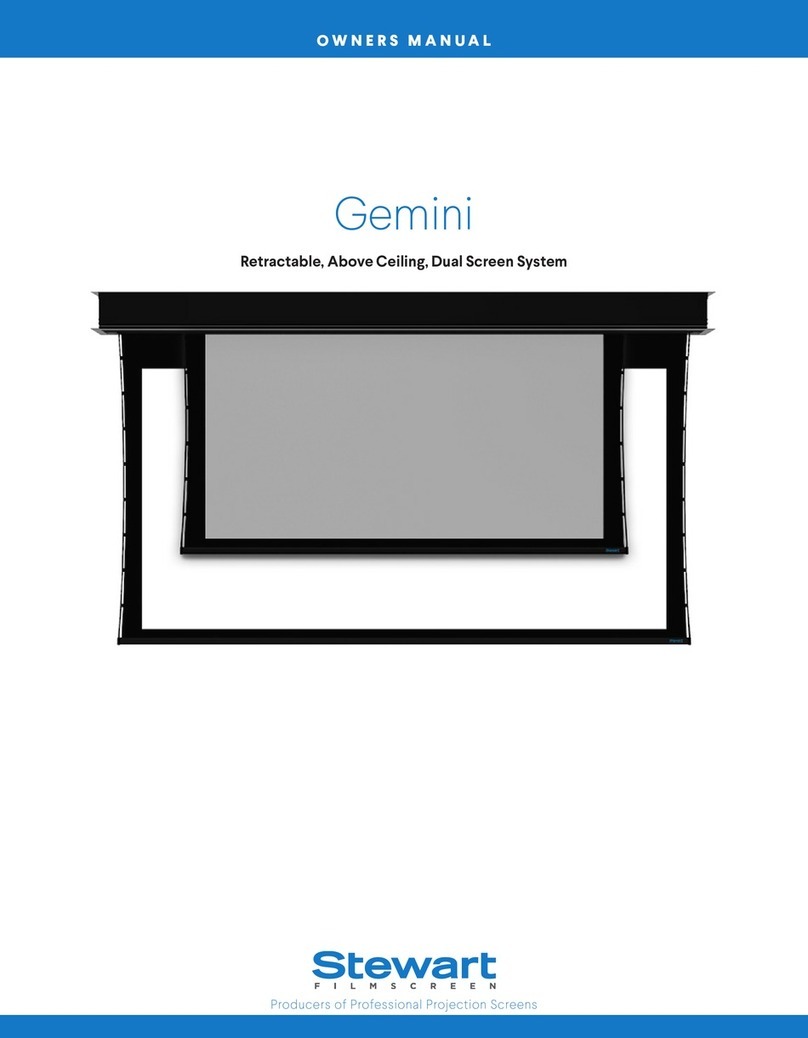
Stewart Audio
Stewart Audio Gemini User manual

Stewart Audio
Stewart Audio Cima AC NT User manual
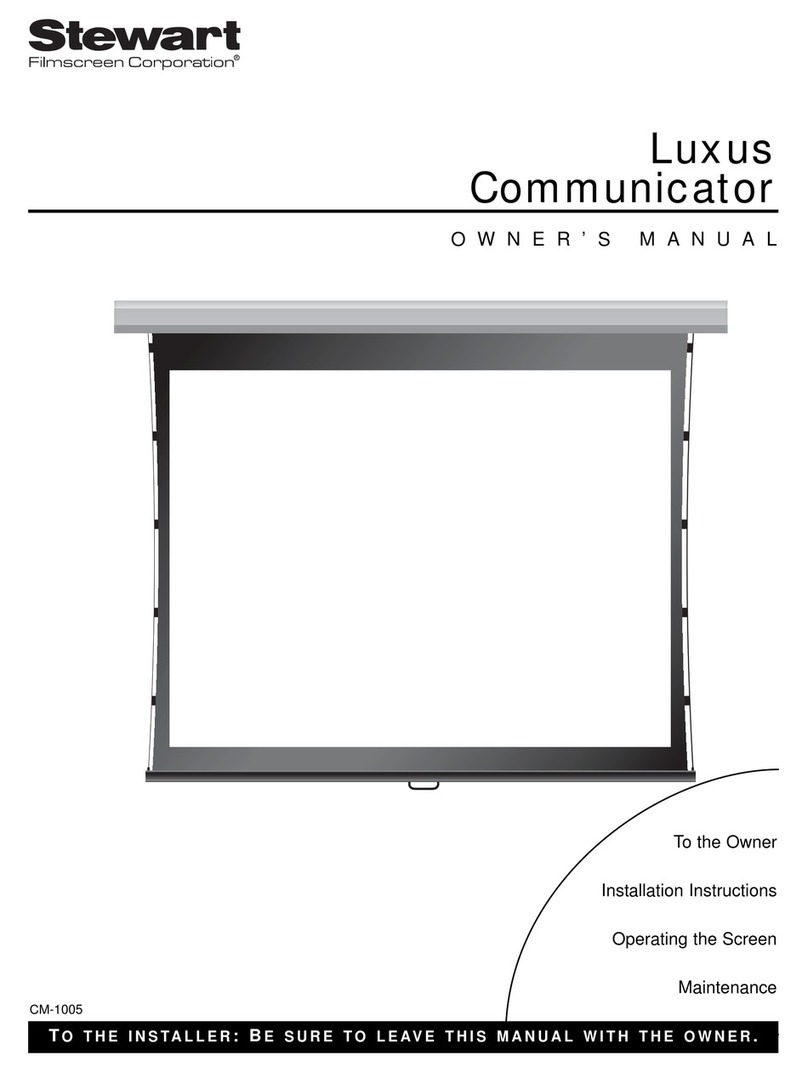
Stewart Audio
Stewart Audio Luxus Communicator User manual

Stewart Audio
Stewart Audio LuminEsse User manual
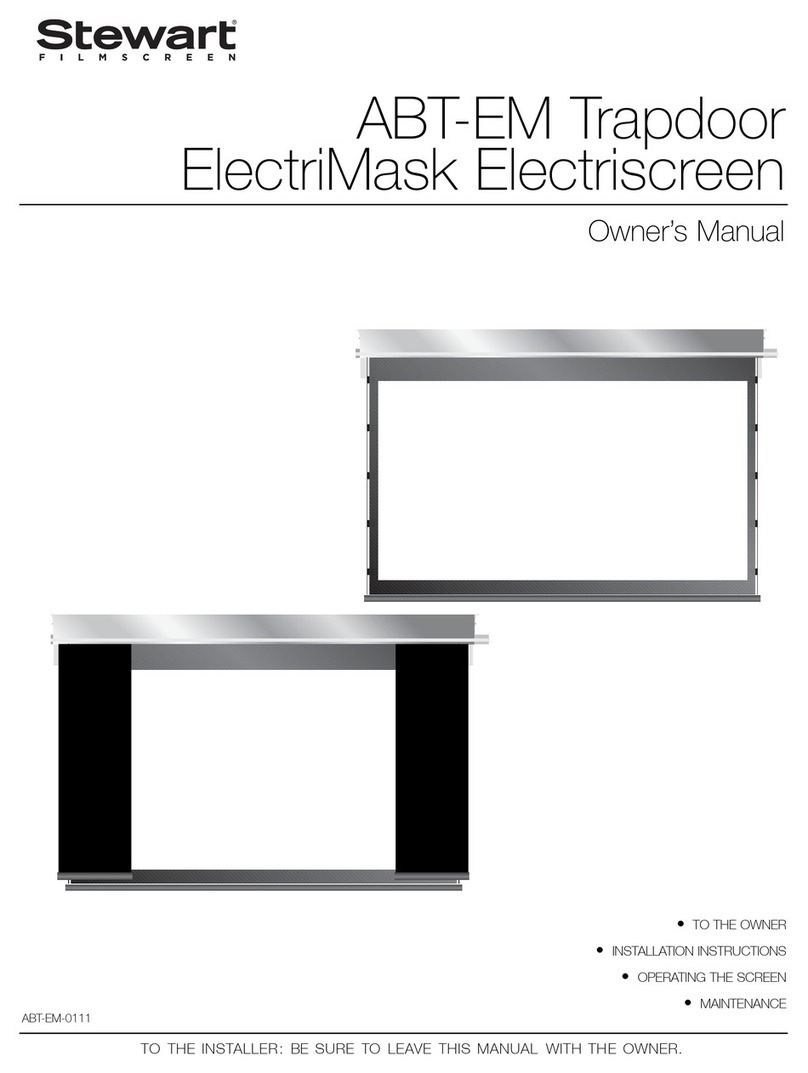
Stewart Audio
Stewart Audio ABT-EM Trapdoor ElectriMask Electriscreen User manual
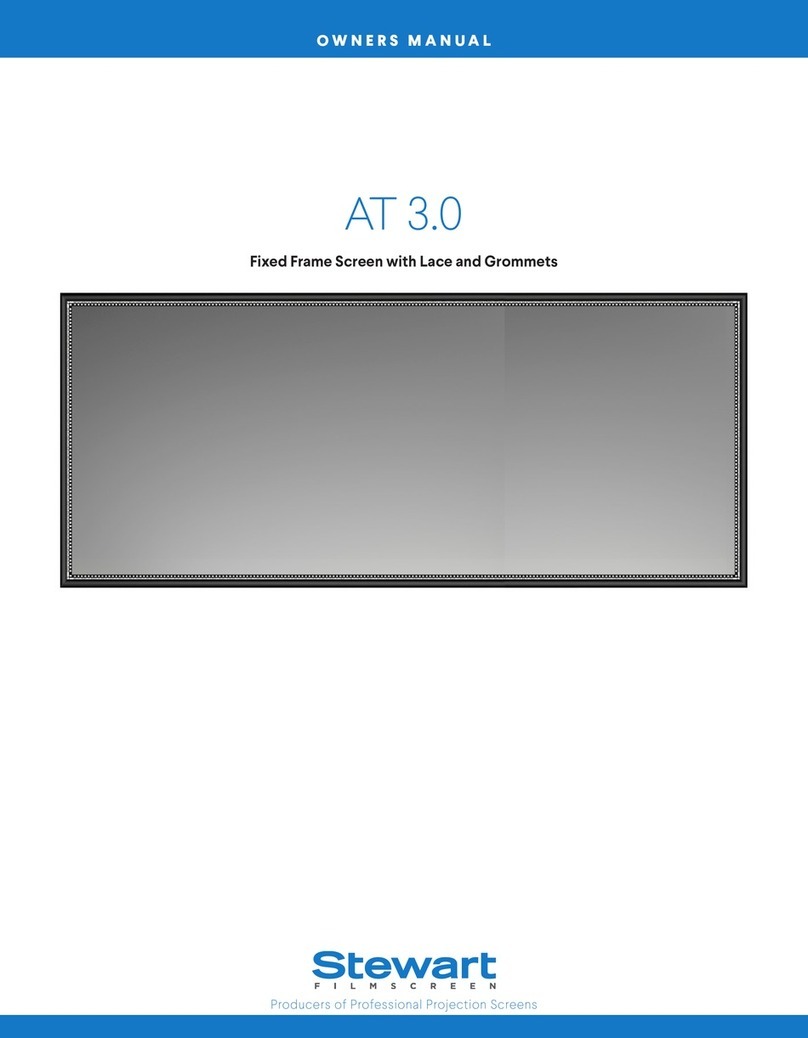
Stewart Audio
Stewart Audio AT 3.0 User manual
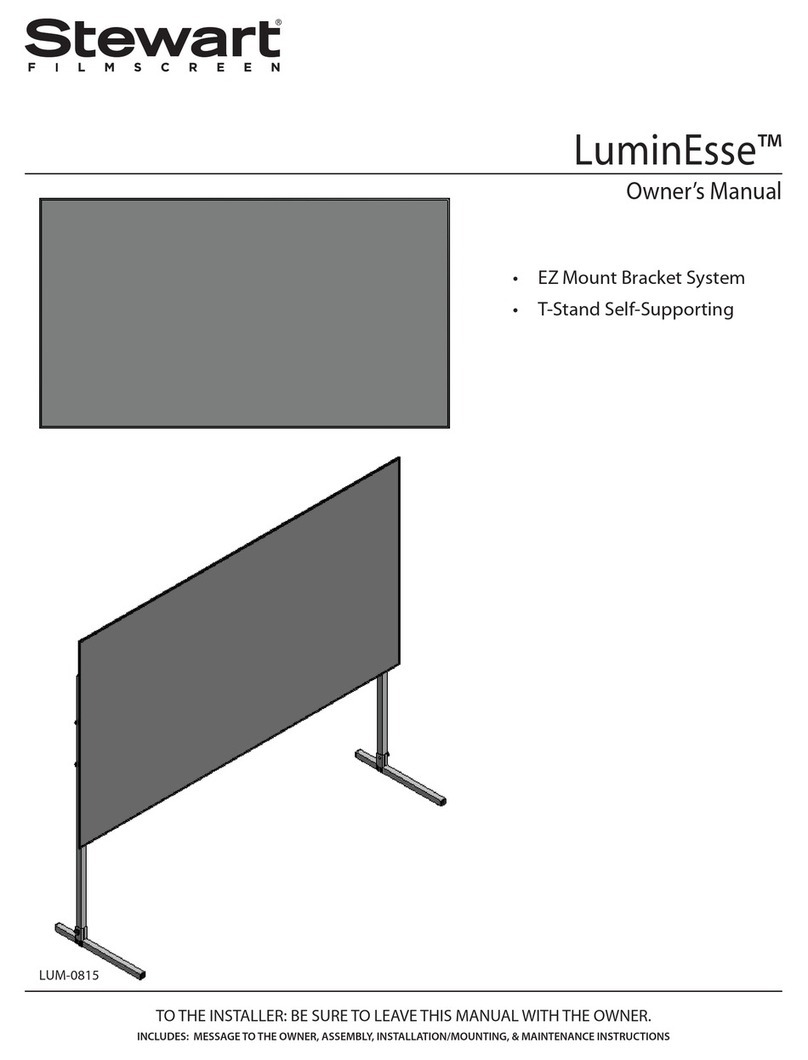
Stewart Audio
Stewart Audio LuminEsse User manual

